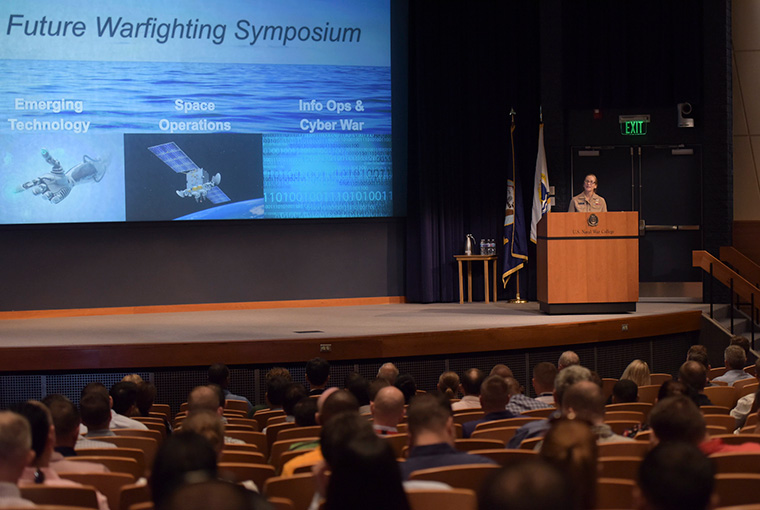Preparing for Tomorrow’s Battlefield: U.S. Naval War College Holds Future Warfighting Symposium

The U.S. Naval War College held its Future Warfighting Symposium Aug. 6-8, the third year of an event focused on cyber warfare, the pace of technological change, space and the impact of social media on conflict.
“The drive to develop new technologies is expanding to more actors, with lower barriers and moving at accelerating speeds,” Cmdr. Michael O’Hara, symposium director, told the audience of Naval War College students.
“Our three-day schedule will encourage you to think more deeply about these challenges and to prepare to engage with them as leaders when you return to the force,” he said.
Naval War College President Rear Adm. Shoshana Chatfield told students that the theme of this year’s symposium is transition – the geopolitical transition to renewed great-power competition and transition in the technologies of war.
She encouraged the assembled students to think over the course of the academic year about how to navigate these transitions.
Strategist Peter W. Singer discussed how the battlefield is being influenced by what he called the weaponization of social media.
“The experience of the internet has not just become like war, it has become an actual new mode of conflict,” said Singer, an author and senior fellow at the New America Foundation.
“If you think of cyber war as the hacking of networks, what we call ‘like war’ is the hacking of people on the networks by driving ideas viral through a mix of ‘likes,’ shares and lies,” said Singer, citing cyber campaigns in recent years that targeted elections in Ukraine and the United States and drove outbreaks of violence in Syria, New Zealand and the American homeland.
“In ‘like war,’ if you can hack this space, you can affect the outcome of physical battles, you can affect terrorist campaigns and which terror group rises and which fails, you can affect not just who people vote for, but whether they even show up to vote,” he said.
Naval War College Provost Lewis Duncan spoke about how emerging science will alter not only our gear and gadgets but even how long humans can live – and how these changes pose new ethical challenges.
Virtual reality is one example, Duncan said, as researchers have calculated how much computing power is required to recreate reality as we know it.
“We are creating the possibility of virtual worlds, almost indistinguishable from the ones we are in,” he said. “The gaming world is nowhere close to that, but if you take Moore’s law and project it, we’ll be there by 2040 or 2045.”
“The question becomes,” Duncan told the audience, “what does it mean to be human?”
Australia’s Maj. Gen. Mick Ryan spoke to the students about leadership in the “cognitive age.”
As commander of the Australian Defence College, Ryan said he has become very invested in what he called “the most important six inches on the battlefield,” which is between our ears.
“How do we as leaders think about generating an intellectual edge over the next couple of decades, and how might technology influence that?” Ryan asked.
Emily O. Goldman, a National Security Agency cyber strategist currently working at the State Department, gave an overview of the U.S. cyber outlook.
“These ideas are evolving every day as we continue to operate in the space and to learn from that experience,” Goldman told the students, advising them that cyber operations shouldn’t be left to the “techy guys and gals” but should be woven into all planning.
Goldman said that major U.S. rivals are trying to use cyberspace to undermine American pre-eminence without crossing the threshold of armed conflict.
“Each of these countries is engaged in what I would call strategic cyber behavior. By strategic I mean, it’s meant to erode the sources of national power. They are doing it in different ways, but their intent is to change the distribution of international power relative to the United States,” Goldman said, citing large-scale intellectual property theft of technology as one example and undermining social cohesion in America as another.
“Cyberspace represents a new seam or a new opportunity in great-power competition. You can gain strategic advantage, increase global influence, and reduce U.S. power without engaging in armed conflict and without ever setting a foot on U.S. soil,” she said.
Gen. Jay Raymond, commander of Air Force Space Command, told students that it’s an exciting and critical time to be in the space business.
“Space is a warfighting domain,” Raymond said, explaining that the great majority of military actions depend on information from satellites. “There’s nothing that we do today in joint warfighting that isn’t enabled by space.”
Raymond then posed the question, What if space is taken away? In other words, what if U.S. rivals significantly block the nation’s ability to use assets in space?
“Space superiority can no longer be considered a given,” he said, adding that the United States is building infrastructure to address this issue. He pointed to the re-establishment later this month of U.S. Space Command as the 11th combatant command.
“One of its main focus areas will be protecting and defending the domain that we’ve become very reliant on as a nation and a world,” Raymond said.
Retired Marine Corps Gen. James Cartwright, who was the 8th vice chairman of the Joint Chiefs of Staff, told students that they should take the year to scrutinize the increasing complexity of the battlefield.
“You have an opportunity to sit down and think about this stuff for the next year. Not just about space,” said Cartwright, who led U.S. Strategic Command from 2004 to 2007.
“You are in fact going to write the policy, going to execute the orders, going to publish the commander’s intent in a world that is focused on speed of light, Mach numbers above 19, along with forces that are on the ground moving to the sound of guns, aircraft that are in support of those assets, but in a military in which we are going to shift from crews per platform to platforms per crew.”
Photos from the 2019 Future Warfighting Symposium are available here: https://flic.kr/s/aHsmFUyJdM
